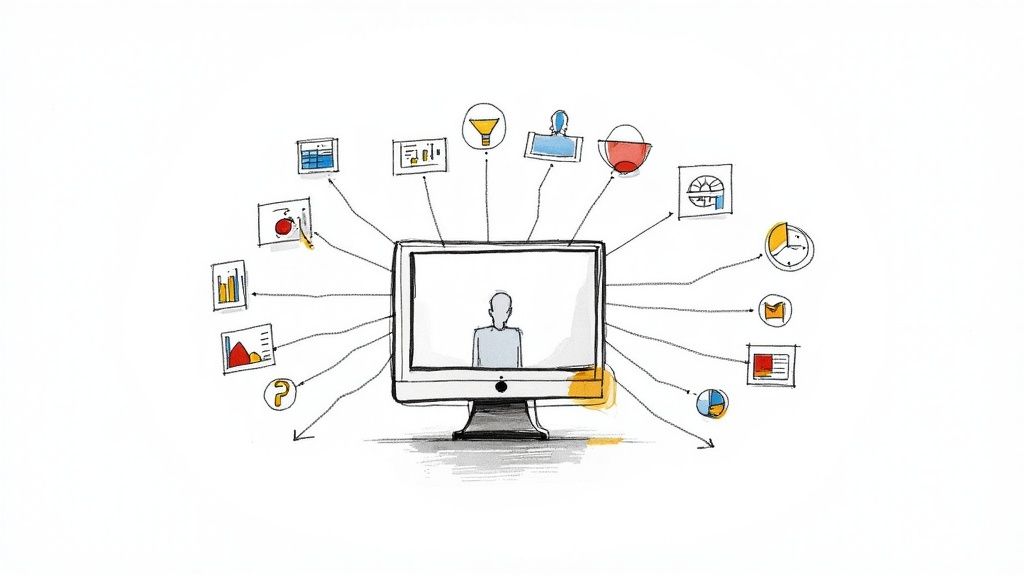Your Guide to SaaS Customer Acquisition Cost
At its core, your SaaS Customer Acquisition Cost (CAC) is the total price you pay in sales and marketing to win a single new paying customer. Think of it as the 'sticker price' for acquiring a new user for your software. Understanding this number is the first critical step toward building a business that’s not just growing, but is actually profitable and sustainable.
What Is SaaS Customer Acquisition Cost Anyway?
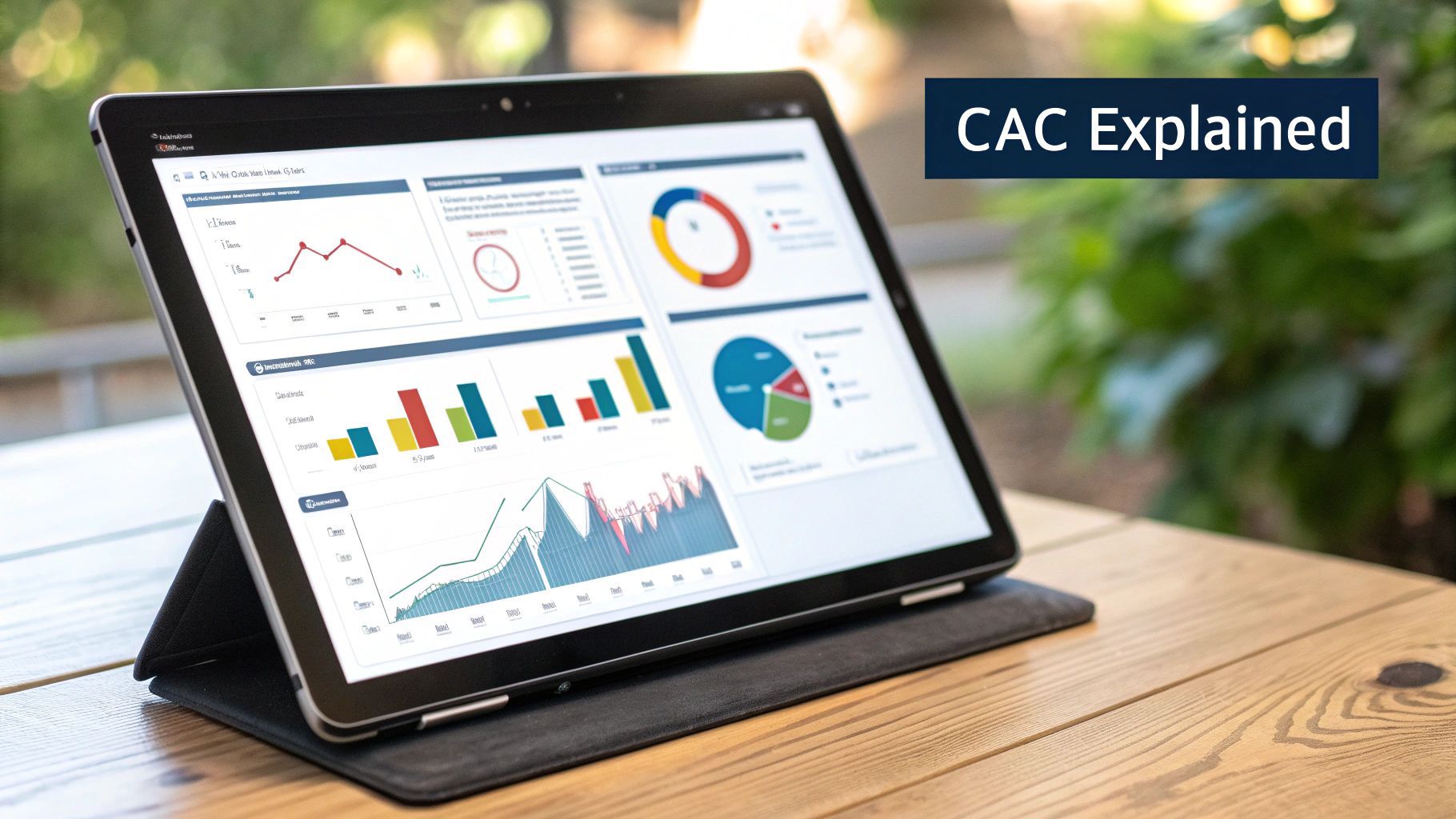
This isn’t just another metric to track in a spreadsheet. Mastering your CAC is absolutely fundamental to scaling your company. It’s the diagnostic tool that tells you whether your business model is truly viable or just a leaky bucket. Without a firm grasp on this figure, you’re flying blind—spending money on ads, content, and sales reps without knowing if you're actually making a profit on each new customer.
Let's use an analogy. Imagine you're building a professional sports team. You wouldn't sign players to big contracts without knowing exactly how much each player costs. Your SaaS CAC is that contract price. Knowing this cost lets you project the future success of your team and figure out if the whole operation can win the championship (or, in this case, turn a profit).
Why This Metric Is Non-Negotiable
Tracking CAC is more than just good accounting; it’s a strategic necessity. It provides clear, direct answers to the most important questions about the health of your SaaS business. A solid understanding of your acquisition costs empowers you to make smarter, data-driven decisions that pave the way for long-term growth.
For instance, this one number helps you:
- Validate Your Business Model: It shows if the lifetime value of a customer (LTV) is higher than what you spent to get them. If your CAC is higher than your LTV, you have a problem.
- Optimize Your Marketing Spend: By seeing which channels bring in customers most affordably, you can funnel your budget into what works and stop wasting money on what doesn't.
- Measure Financial Health: Investors and stakeholders always look at CAC. It’s a key indicator of your company's efficiency and potential to scale.
- Improve Unit Economics: It’s the core of your unit economics, telling you the story of profitability one customer at a time.
In short, your SaaS customer acquisition cost is the pulse of your growth engine. It tells you how much fuel (money) you need to add more horsepower (customers) and whether that engine can actually run for the long haul.
To get a true picture of your CAC, you need to tally up all the costs that go into your customer acquisition machine.
Core Components of Your SaaS CAC
Let's break down the typical sales and marketing expenses that feed into this calculation.
Getting these inputs right is the key to an accurate calculation.
Once you have a firm grip on this foundational metric, you can start fine-tuning your growth strategy. Knowing your number is the critical first step before moving on to the next one: actually calculating it. That insight opens the door to spotting inefficiencies and deploying smart tactics to bring those costs down, making sure every dollar you spend is pushing your business forward.
How to Calculate Your SaaS CAC with Confidence
Figuring out your SaaS customer acquisition cost can feel like a daunting task, but it really boils down to a simple, honest look at your spending. This number is the price tag on your growth engine, and getting it right is the first step toward building a truly profitable company. It's less about complex accounting and more about knowing where your money is going.
At its core, the formula is refreshingly straightforward:
CAC = Total Sales & Marketing Expenses ÷ Number of New Customers Acquired
This simple equation gives you an incredibly powerful metric. It tells you exactly how much you had to spend to get each new paying customer through the door over a specific period. The real work, though, lies in defining what goes into each part of that equation.
Tallying Your Total Sales and Marketing Spend
To get a truly accurate CAC, you have to be meticulous. This isn't just about your ad budget; it’s every single dollar you spend to win new business. Think of it like calculating the total cost of a road trip—you wouldn't just count the gas. You'd factor in the food, the tolls, and maybe even the extra oil change you needed beforehand.
Here are the essential costs that absolutely must be in your calculation:
- Salaries and Commissions: This is a big one. It includes the wages, bonuses, and commissions for everyone on your sales and marketing teams.
- Advertising Spend: Every penny you spend on paid channels counts. That means Google Ads, LinkedIn campaigns, social media promotions, and sponsorships.
- Content and Creative Costs: The money it takes to create your marketing materials, from freelance writer fees and designer costs to video production expenses.
- Software and Tools: Don't forget your tech stack. This includes subscriptions for your CRM, marketing automation platform, and SEO tools that support your acquisition efforts.
- Overhead Allocation: A fair portion of your general business overhead (like rent or utilities) should be attributed to supporting the sales and marketing teams.
Getting all these numbers together for a specific period of time is the first half of the puzzle. Now for the second.
Defining Your Time Frame and Customer Count
Choosing the right time frame is key to getting a meaningful number. You could calculate CAC monthly, quarterly, or even annually. A monthly calculation can be a bit wild, swinging up and down with ad spend or a single big deal. An annual view, on the other hand, smooths things out but might not be responsive enough.
For most SaaS companies, a quarterly calculation often hits the sweet spot. It provides a stable, reliable snapshot of your performance that's still timely.
Once you’ve picked your time frame—say, Q2, from April 1st to June 30th—you just need to count up the number of new paying customers you brought in during that exact window. It's critical to only count net-new customers here, not existing ones who simply upgraded their plan.
This simple, three-step process for calculating your SaaS CAC is visualized below.
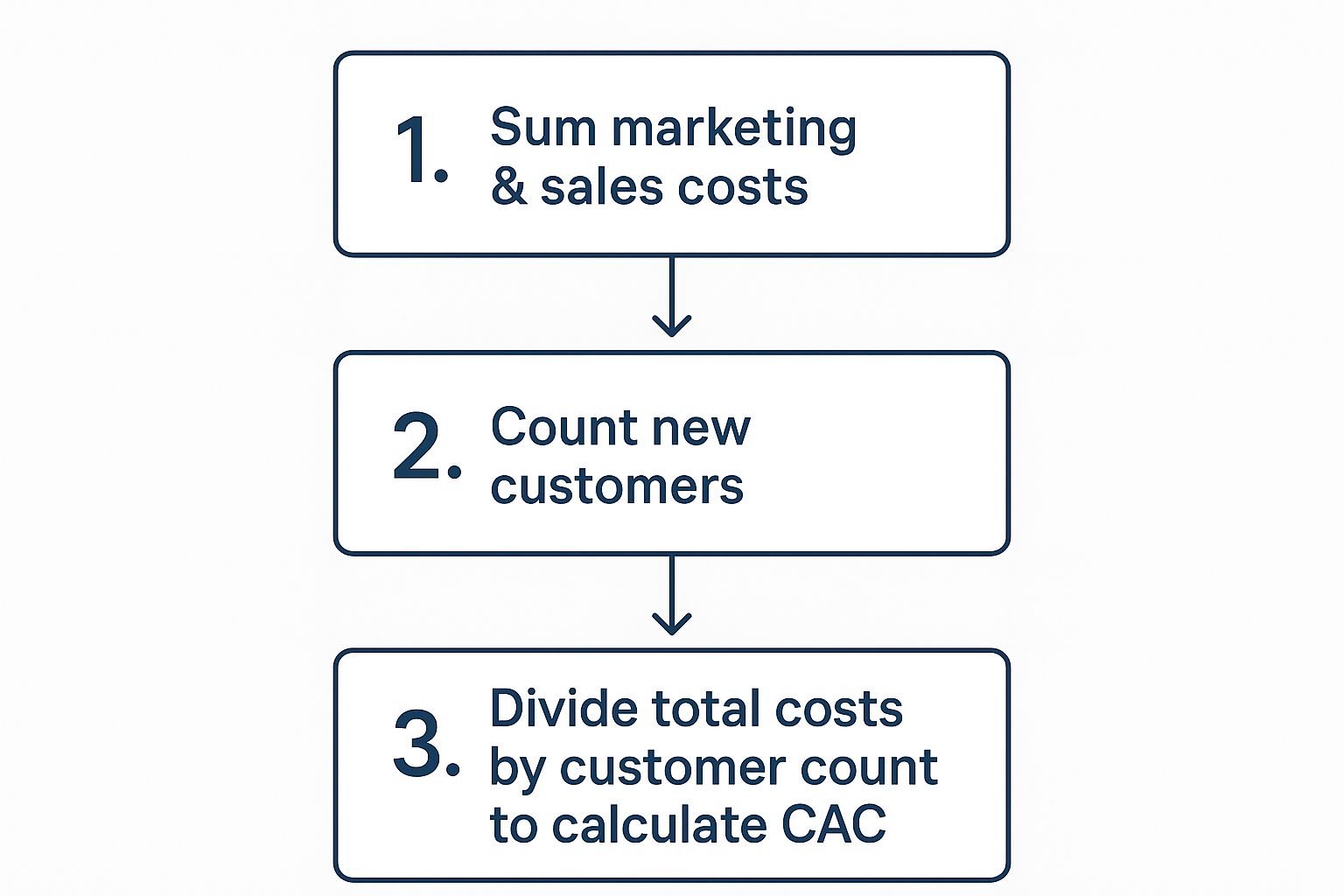
As you can see, it's a logical flow: add up all your costs, count your new customers, and then do the final division to find your cost per acquisition.
Let's walk through a quick example to make this real. Imagine a startup wants to figure out its CAC for the last quarter.
- Sales & Marketing Salaries: $60,000
- Ad Spend: $25,000
- Software Subscriptions: $5,000
- Total Expenses = $90,000
- During that same quarter, they signed up 150 new paying customers.
- $90,000 ÷ 150 = $600
- Product-Led Growth (PLG) Model: Think of a self-serve tool with a low monthly price. The sales cycle might be just a few hours. A user finds you, signs up for a free trial, loves the product, and converts without ever speaking to a human. The CAC here is naturally low.
- Enterprise Sales Model: Now picture a complex platform sold to large corporations. The sales cycle could easily stretch from six to twelve months. This process involves juggling multiple stakeholders, creating custom proposals, and navigating lengthy negotiations, all of which dramatically inflate your SaaS customer acquisition cost.
- Go All-In on High-ROI Channels: Prioritize organic search (SEO) and content marketing. Yes, they take time and effort upfront, but they build a long-term asset that generates leads without you having to constantly feed the ad machine.
- Get Surgical with Paid Ads: Stop spraying and praying. Get granular with your ad campaigns. Use negative keywords to filter out irrelevant clicks, target laser-specific demographics, and build lookalike audiences from your best customers. Make sure every ad dollar is spent reaching a highly relevant prospect.
- A/B Test Everything: Never assume you have the "perfect" ad. Constantly test different headlines, images, and calls-to-action. Even a tiny bump in your click-through rate can slash your cost per acquisition.
- Nail the Landing Page Experience: Your landing pages need a crystal-clear value proposition and one obvious call-to-action. Get rid of distracting clutter and make sure the page’s message perfectly matches the ad that brought the person there.
- Simplify the Signup Process: Is your signup form asking for their life story? Stop it. Each extra field is another reason for someone to give up. Ask for only the absolute bare minimum needed to get them started.
- Streamline User Onboarding: A confusing onboarding experience is a fast track to churn. You need to guide new users to that "aha!" moment—the point they truly get your product's value—as quickly as you can. Use in-app tours, tooltips, and clear guidance.
- Launch a Referral Program: Give your happy customers a reason to tell their friends. Offering a small credit, a discount, or an exclusive feature for a successful referral brings in high-quality new users for pennies on the dollar compared to traditional marketing.
- Build-in Shareable Features: Create features that are inherently collaborative. If a user can easily share a report, invite a teammate, or collaborate on a project, they become your marketing department.
- Focus on Customer Retention: It might sound backward, but keeping customers is key to lowering your net CAC. Happy customers stick around longer, are more likely to upgrade, and—most importantly—are your best source of referrals. To dive deeper, you can learn how to improve customer retention in our complete guide.
- Cost Per Lead (CPL): This is your top-of-funnel cost. It tells you how much you're spending to get someone to raise their hand and show interest, like by downloading a whitepaper.
- SaaS Customer Acquisition Cost (CAC): This is your bottom-of-funnel cost. It measures the full price tag for turning an interested prospect into a paying customer.
- Forgetting Salaries: This is the big one. The salaries for your sales and marketing teams are almost always your biggest acquisition expense, so they have to be in the formula.
- Mixing Up New and Existing Customers: Your CAC calculation should only include net-new customers. Revenue from upselling existing customers is fantastic, but it belongs in your LTV calculation, not here.
- Ignoring Tool Costs: Don't forget to add up the monthly or annual costs for your CRM, marketing automation software, analytics tools, and anything else your teams use to attract customers.
- Using the Wrong Time Frame: Make sure the period you use for your expenses perfectly matches the period in which you acquired the new customers. Any mismatch will throw your numbers off.
In this scenario, the startup’s SaaS customer acquisition cost for the quarter is $600. This single number is their new baseline, a benchmark they can use to judge everything from marketing campaigns to their overall financial health. With this figure in hand, you can finally start asking the bigger, more strategic question: is that a good number?
The Hidden Factors Driving Your SaaS CAC
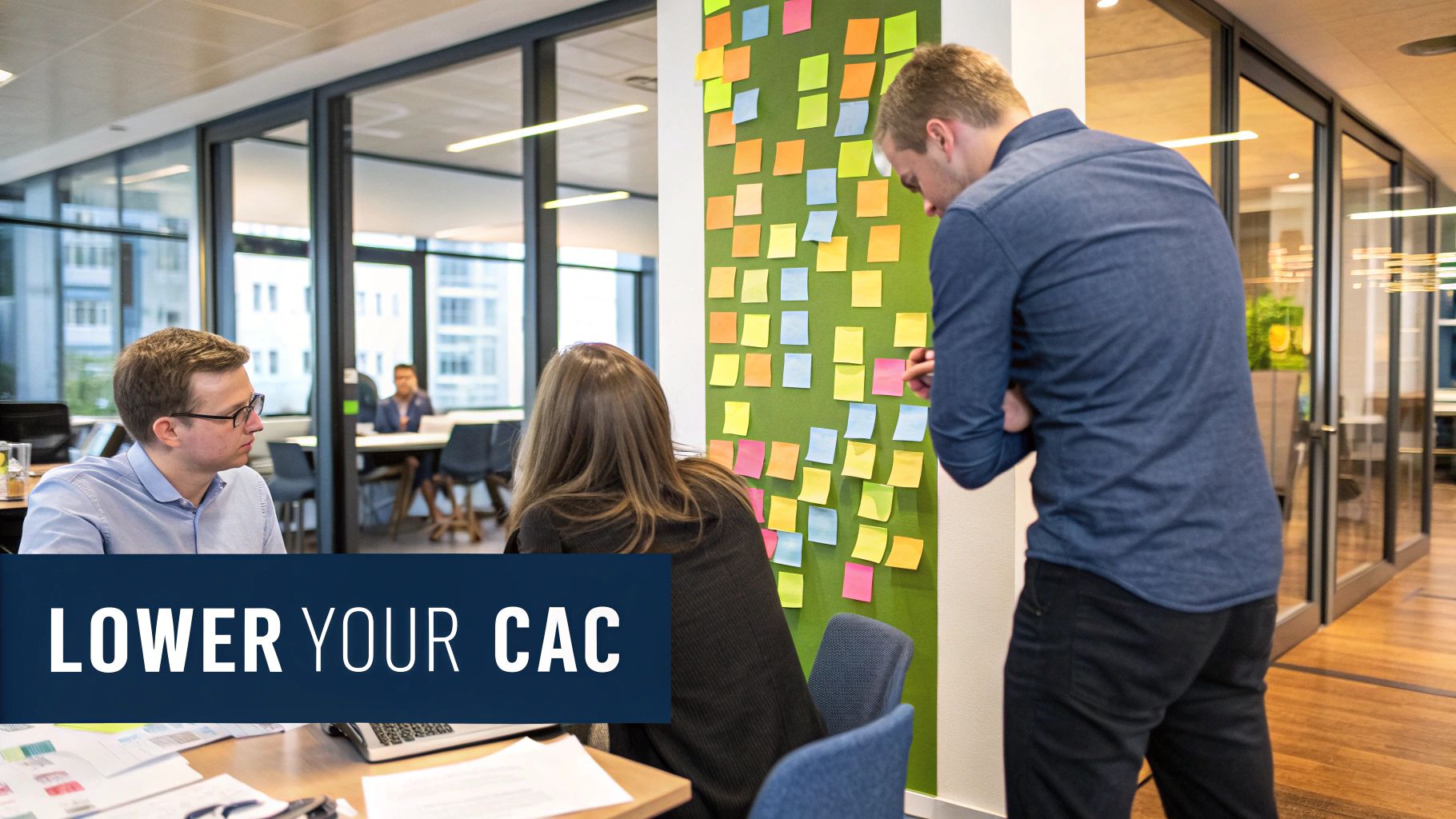
Calculating your SaaS customer acquisition cost gives you a number, but a number alone doesn't tell the whole story. To really get a handle on your business, you need to dig into the hidden forces pushing that figure up or down. Think of it like being a detective for your own growth strategy—you have the evidence (your CAC), and now it's time to investigate the scene.
Several key drivers are always working behind the scenes, shaping your acquisition costs. Once you understand these levers, you can stop just knowing your CAC and start actively influencing it. These factors are the 'why' behind your spending and are absolutely critical for building a smarter, more efficient growth plan.
Market Competition and Saturation
How crowded is your playground? The intensity of your market plays a massive role in how much you have to spend. If you're in a packed space with dozens of competitors all bidding on the same keywords and chasing the same audience, your costs are going to climb. It’s simple economics. More competition means you have to spend more just to get noticed.
On the flip side, if you've carved out a unique niche with a clear value proposition, you can often acquire customers much more affordably. Your message cuts through the noise instead of getting lost in it, and you aren't forced into those expensive bidding wars for ad space.
And things are only getting tougher. Over the past decade, CAC has shot up by a staggering 222% across industries, largely thanks to this fierce competition and rising ad prices. This trend really underscores why SaaS companies need to get sharp with their strategies. In fact, inefficient acquisition can lead to an average loss of $29 per new customer.
Sales Cycle Length and Complexity
The time it takes to turn a curious lead into a paying customer has a direct—and significant—impact on your CAC. A longer sales cycle simply consumes more resources. It means more follow-up emails, more demos, more content for nurturing, and more of your sales team's valuable time.
Just look at two common scenarios:
Ultimately, the complexity of your product and the buying process of your ideal customer are directly tied to how much you have to invest to seal the deal.
Ideal Customer Profile and Pricing Model
Who you sell to and how you price your product are deeply connected to your acquisition costs. Selling a $50/month subscription to a small business is a completely different ballgame than selling a $50,000/year contract to a Fortune 500 company.
Your Ideal Customer Profile (ICP) dictates your entire strategy. A high-value enterprise customer justifies a much higher CAC because their lifetime value (LTV) is proportionally massive. You can afford to invest more in personalized outreach and a dedicated sales team.
Your pricing model also sets the rules of the game. Freemium plans or low-cost tiers often rely on achieving high volume and word-of-mouth to keep CAC down. In contrast, premium-priced products demand a more targeted, high-touch approach. There’s no single "right" model, but your strategy must align with what you can sustainably spend to acquire each user.
No matter the model, effective communication is what ultimately converts users. For a deeper dive on this, check out our guide on essential customer communication strategies for SaaS.
Is Your SaaS CAC Actually Good or Bad?
So you've calculated your SaaS customer acquisition cost. That's a huge first step, but it’s really only half the story. A CAC of $500 might be a fantastic deal for one company and an absolute disaster for another.
The real question isn't just "What is my CAC?"—it's "Is my CAC building a profitable business?" To get the full picture, you have to put that number in context by comparing it to the value those customers bring in over their lifetime.
This means looking beyond vague industry averages and measuring your CAC against two metrics that truly reveal the health of your growth engine: Lifetime Value (LTV) and your CAC Payback Period.
The Gold Standard: The LTV to CAC Ratio
In the world of SaaS, no relationship is more important than the one between Lifetime Value (LTV) and Customer Acquisition Cost. Your LTV is the total revenue you can reasonably expect from a single customer throughout their entire time with you.
Think of the LTV to CAC ratio as the ultimate test of your business model's viability. It tells you exactly how much you're getting back for every dollar you put into sales and marketing.
LTV to CAC Ratio = Lifetime Value ÷ Customer Acquisition Cost
A healthy ratio shows you're spending your money wisely to bring in customers who stick around and generate a profit. On the flip side, a poor ratio is a major red flag.
For most SaaS companies, a ratio of 3:1 is the magic number. It means that for every dollar you spend to win a customer, you earn three dollars back. This is widely seen as the benchmark for a healthy, scalable business. Anything lower suggests you're spending too much for too little in return.
Let's break down what these different ratios really mean for your day-to-day operations and what you should do next.
Interpreting Your LTV to CAC Ratio
The relationship between Lifetime Value (LTV) and Customer Acquisition Cost (CAC) offers a direct look into the health of your SaaS business. Here’s how to interpret your ratio and decide on your next move.
Understanding your LTV:CAC ratio is crucial, but it's not just an academic exercise—it's a guide that tells you whether to step on the gas, pump the brakes, or head back to the workshop.
Measuring Your CAC Payback Period
While the LTV:CAC ratio gives you the long-term view, the CAC Payback Period answers a much more immediate question: "How long until we get our money back?"
This metric calculates the number of months it takes for a new customer's revenue to completely cover their initial acquisition cost. It’s a gut check on your company's cash flow and capital efficiency.
Here's the formula:
CAC Payback Period (in months) = CAC ÷ (Average Revenue Per Account x Gross Margin)
A shorter payback period is always better. It means you recover your cash faster, which you can then turn around and reinvest into acquiring the next wave of customers. For most venture-backed SaaS companies, a payback period of under 12 months is the goal.
If it takes much longer than a year, your growth can slow to a crawl because your cash is tied up for too long. A short payback period, on the other hand, is the fuel for rapid, sustainable growth.
Actionable Strategies to Lower Your SaaS CAC
Alright, you've done the math and you know your SaaS customer acquisition cost. That's the diagnostic. Now it's time to actually treat the patient and bring that number down.
Lowering your CAC isn’t just about spending less money. It’s about spending smarter. It means making focused, efficient investments to attract the right customers—the ones who stick around.
This is the playbook. We're going to walk through the proven strategies that successful SaaS companies use to build a more profitable growth engine. It all comes down to fine-tuning your marketing, smoothing out your sales funnel, and turning your existing customers into your best advocates.
Optimize Your Marketing Engine
Your marketing channels are the biggest levers you can pull to influence your acquisition costs. By getting serious about which channels actually deliver a return and sharpening your targeting, you can cut out the waste and double down on what works.
First things first: dig into your analytics. You need a clear picture of where your best customers are coming from. Is it organic search? Paid ads? Social media? Find the sources that bring in valuable, long-term users for the lowest cost.
Once you know what's working, the path is clear. This isn't about being everywhere; it's about being in the right places at the right time.
Here are a few key optimizations to focus on:
When you start treating your marketing budget like a strategic investment portfolio instead of a line-item expense, you naturally start shifting resources to the activities that deliver real results, directly pushing your CAC down.
Boost Conversion Rates Across the Funnel
Every single visitor who hits your site and leaves without signing up is a sunk cost. That's acquisition spend that went straight down the drain. This makes optimizing your conversion rates one of the most powerful ways to lower your SaaS customer acquisition cost.
Think of your funnel as a path with several gates. Your job is to grease the hinges on every single one. From the moment someone lands on your page to the second they become a paying customer, you need to make the journey as frictionless as possible.
A higher conversion rate means you get more customers from the same amount of traffic and marketing spend. This directly and powerfully reduces your CAC without needing to generate a single extra lead.
This means putting on your user's hat and meticulously walking through every touchpoint. Where are people getting stuck? What's causing them to drop off? Find that friction and eliminate it.
Some of the highest-impact conversion rate optimization (CRO) tactics include:
Leverage Product-Led Growth and Referrals
Sometimes, your best salesperson is your product itself. A product-led growth (PLG) strategy makes your software the main driver of customer acquisition, creating a far more scalable and cost-effective growth model.
PLG usually leans on a freemium or free trial model, letting users see and feel the product's value before they ever have to pull out a credit card. When the product sells itself, the need for a costly, high-touch sales team shrinks dramatically.
On top of that, a great product is a natural engine for word-of-mouth marketing—the cheapest and most effective acquisition channel there is. You can supercharge this by building viral loops right into your product.
Try implementing these strategies:
By making your product the star of the show, you empower your customers to become your champions. This creates a powerful, self-sustaining growth loop that keeps your SaaS customer acquisition cost exactly where you want it: low.
Your Top SaaS CAC Questions, Answered
When you start digging into SaaS customer acquisition cost, you'll inevitably run into some tricky questions. How do you calculate it? What does "good" even look like? Getting these details right is crucial for making smart decisions.
This section is designed to give you clear, no-nonsense answers to the questions we hear most often from SaaS founders and marketers.
What Is a Good SaaS CAC?
This is the million-dollar question, and the honest answer is: it depends. A "good" CAC is never a standalone number; it only makes sense when you compare it to your Customer Lifetime Value (LTV).
The gold standard in the SaaS world is an LTV to CAC ratio of 3:1 or higher. In plain English, this means you're making at least three dollars back for every dollar you spend to get a new customer. If you're consistently below that 3:1 mark, you might be burning through cash too quickly to build a sustainable business.
How Often Should I Calculate CAC?
Timing is everything. Calculate it too often, and your data will be noisy and unreliable. Wait too long, and you'll miss your chance to fix problems before they get out of hand. For most SaaS businesses, hitting a quarterly calculation is the perfect middle ground.
A quarterly window is long enough to smooth out the noise from a big marketing push one month or a few massive deals the next. But it’s still frequent enough to give you a clear, actionable signal on whether your strategy needs a tune-up.
Should I Include Freemium User Costs in My CAC?
This is a classic point of confusion. The short answer is no, but it’s a bit more nuanced than that. The ongoing costs to support your free users—things like server space and basic support—are generally considered part of your Cost of Goods Sold (COGS), not acquisition.
However, any money you spend on marketing specifically to get people to sign up for your free trial or freemium plan absolutely should be included in your total acquisition spending. The key is to be disciplined on the other side of the equation: only count the users who actually convert to a paid plan as "new customers." This keeps your calculation focused on what it truly costs to acquire a paying customer.
How Does CAC Differ from Cost Per Lead (CPL)?
It's easy to mix these two up, but they measure completely different stages of your customer's journey.
Your CPL will always be much, much lower than your CAC. Tracking both is incredibly useful.
For instance, if you have a great, low CPL but your CAC is through the roof, you know the problem isn't generating interest—it's closing deals. The leak is somewhere in your sales process or trial experience.
What Are Some Common Mistakes to Avoid When Calculating CAC?
Garbage in, garbage out. A sloppy CAC calculation can lead you to make some seriously bad business decisions. For more on this and other topics, feel free to check out our main FAQ page.
Here are the most common mistakes we see people make:
Ready to turn more website visitors into loyal customers and drive down your acquisition costs? Worknet.ai Inc uses AI-powered chat to engage leads, guide trial users, and support customers 24/7. See how you can build a more efficient growth engine at https://worknet.ai.
FAQs
.png)
Lorem ipsum dolor sit amet, consectetur adipiscing elit. Suspendisse varius enim in eros elementum tristique. Duis cursus, mi quis viverra ornare, eros dolor interdum nulla, ut commodo diam libero vitae erat. Aenean faucibus nibh et justo cursus id rutrum lorem imperdiet. Nunc ut sem vitae risus tristique posuere.
Lorem ipsum dolor sit amet, consectetur adipiscing elit. Suspendisse varius enim in eros elementum tristique. Duis cursus, mi quis viverra ornare, eros dolor interdum nulla, ut commodo diam libero vitae erat. Aenean faucibus nibh et justo cursus id rutrum lorem imperdiet. Nunc ut sem vitae risus tristique posuere.
Lorem ipsum dolor sit amet, consectetur adipiscing elit. Suspendisse varius enim in eros elementum tristique. Duis cursus, mi quis viverra ornare, eros dolor interdum nulla, ut commodo diam libero vitae erat. Aenean faucibus nibh et justo cursus id rutrum lorem imperdiet. Nunc ut sem vitae risus tristique posuere.
Lorem ipsum dolor sit amet, consectetur adipiscing elit. Suspendisse varius enim in eros elementum tristique. Duis cursus, mi quis viverra ornare, eros dolor interdum nulla, ut commodo diam libero vitae erat. Aenean faucibus nibh et justo cursus id rutrum lorem imperdiet. Nunc ut sem vitae risus tristique posuere.
Lorem ipsum dolor sit amet, consectetur adipiscing elit. Suspendisse varius enim in eros elementum tristique. Duis cursus, mi quis viverra ornare, eros dolor interdum nulla, ut commodo diam libero vitae erat. Aenean faucibus nibh et justo cursus id rutrum lorem imperdiet. Nunc ut sem vitae risus tristique posuere.
Lorem ipsum dolor sit amet, consectetur adipiscing elit. Suspendisse varius enim in eros elementum tristique. Duis cursus, mi quis viverra ornare, eros dolor interdum nulla, ut commodo diam libero vitae erat. Aenean faucibus nibh et justo cursus id rutrum lorem imperdiet. Nunc ut sem vitae risus tristique posuere.
Lorem ipsum dolor sit amet, consectetur adipiscing elit. Suspendisse varius enim in eros elementum tristique. Duis cursus, mi quis viverra ornare, eros dolor interdum nulla, ut commodo diam libero vitae erat. Aenean faucibus nibh et justo cursus id rutrum lorem imperdiet. Nunc ut sem vitae risus tristique posuere.
Lorem ipsum dolor sit amet, consectetur adipiscing elit. Suspendisse varius enim in eros elementum tristique. Duis cursus, mi quis viverra ornare, eros dolor interdum nulla, ut commodo diam libero vitae erat. Aenean faucibus nibh et justo cursus id rutrum lorem imperdiet. Nunc ut sem vitae risus tristique posuere.
Lorem ipsum dolor sit amet, consectetur adipiscing elit. Suspendisse varius enim in eros elementum tristique. Duis cursus, mi quis viverra ornare, eros dolor interdum nulla, ut commodo diam libero vitae erat. Aenean faucibus nibh et justo cursus id rutrum lorem imperdiet. Nunc ut sem vitae risus tristique posuere.
Lorem ipsum dolor sit amet, consectetur adipiscing elit. Suspendisse varius enim in eros elementum tristique. Duis cursus, mi quis viverra ornare, eros dolor interdum nulla, ut commodo diam libero vitae erat. Aenean faucibus nibh et justo cursus id rutrum lorem imperdiet. Nunc ut sem vitae risus tristique posuere.

.svg)

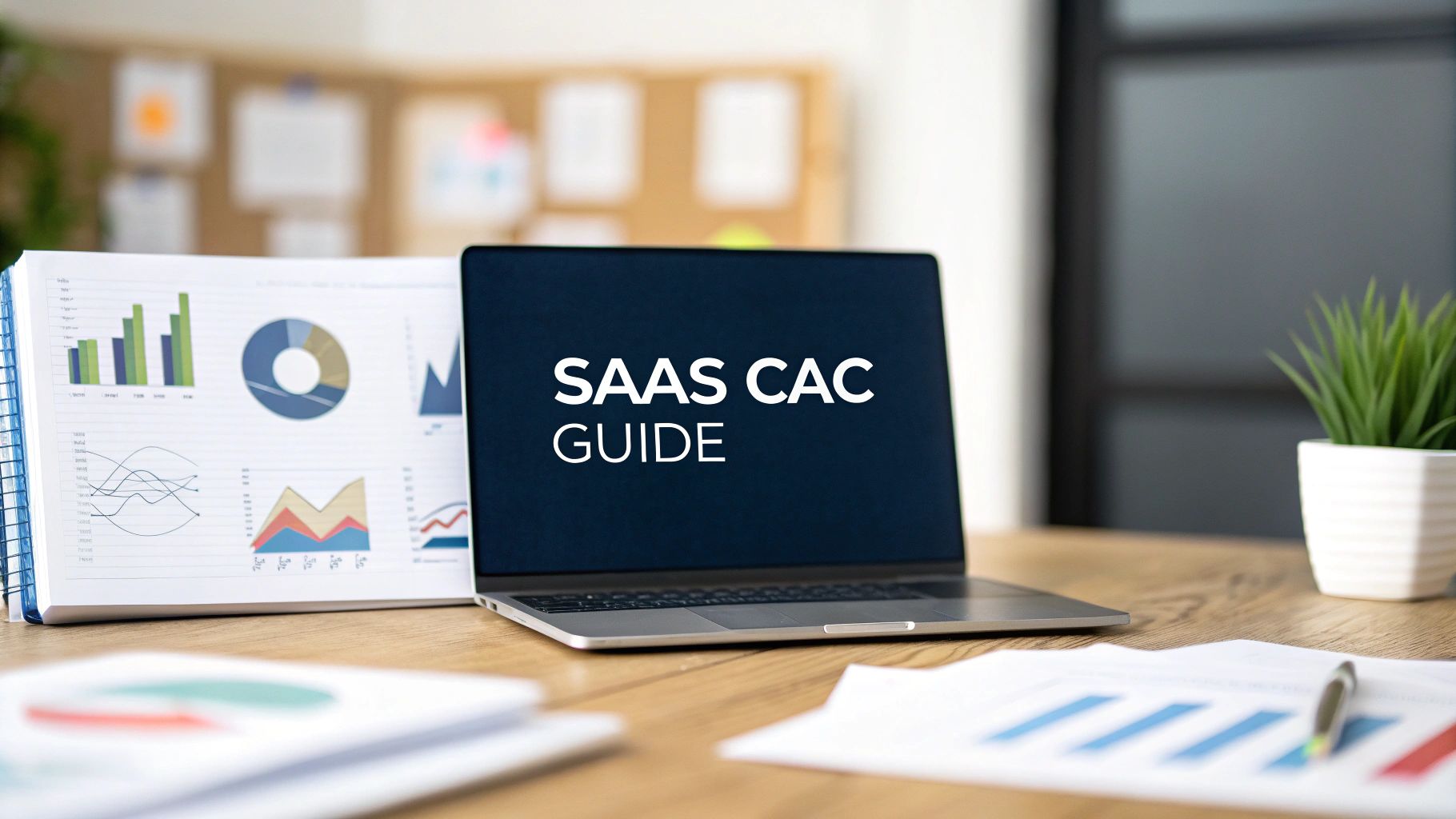
.webp)
.webp)
.webp)





